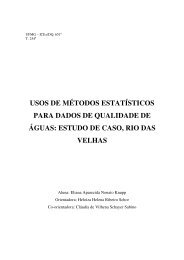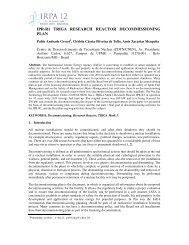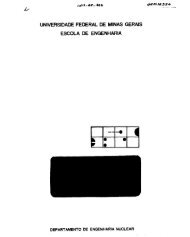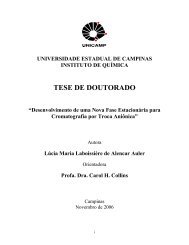thermocouples recovery of one triga instrumented fuel rod ... - CDTN
thermocouples recovery of one triga instrumented fuel rod ... - CDTN
thermocouples recovery of one triga instrumented fuel rod ... - CDTN
Create successful ePaper yourself
Turn your PDF publications into a flip-book with our unique Google optimized e-Paper software.
4.4 Quality control<br />
The isolation between <strong>thermocouples</strong> wires and the stainless shield and the continuity <strong>of</strong> the<br />
wires were tested using a digital multimeter. The temperature was measured with the<br />
extension cable connected to <strong>one</strong> digital temperature indicator. Table 3 shows the results.<br />
Thermocouple<br />
Position<br />
Tab. 3. Thermocouples measurements<br />
Wire Electrical<br />
Resistance<br />
[Ω]<br />
Isolation<br />
[Ω]<br />
Temperature<br />
[ o C]<br />
Superior 85.0 22 23.4<br />
Medium 87.4 20 23.6<br />
Inferior 86.1 30 24.2<br />
The <strong>thermocouples</strong> isolation was very lower than new <strong>one</strong> and the wire electrical resistances<br />
(loop continuities) are correct to this <strong>thermocouples</strong> kind and dimensions. The water<br />
temperature was <strong>of</strong> the same magnitude order <strong>of</strong> a calibrated thermocouple that was<br />
inserted in the well. So, it was concluded that the <strong>instrumented</strong> <strong>fuel</strong> element could return to<br />
the reactor core and to monitoring the temperature.<br />
It was made the connection <strong>of</strong> the connector female half (linked to the <strong>thermocouples</strong> wires)<br />
to the male part <strong>of</strong> the connector (linked to the extension cables). Layers <strong>of</strong> silicon rubber<br />
were placed inside and around the connector to mechanical and electrical protection. On the<br />
other day the IF was lowered until the bottom <strong>of</strong> the storage <strong>fuel</strong> irradiated well immersed in<br />
water (3m deep). The <strong>thermocouples</strong> extension cables were connected to the IPR-R1<br />
TRIGA data acquisition system [7]. It was observed that two <strong>of</strong> the three <strong>thermocouples</strong><br />
already more did not indicate correctly the temperature.<br />
5. Conclusion<br />
At the moment only <strong>one</strong> <strong>of</strong> the IF <strong>thermocouples</strong> is working and measuring the water<br />
temperature <strong>of</strong> the <strong>fuel</strong> irradiated storage well, the values are near the surrounding<br />
temperature. The behavior <strong>of</strong> this thermocouple is uncertain if the IF was used to monitoring<br />
the reactor core operational temperatures <strong>of</strong> the order <strong>of</strong> 190 o C, in the reactor operations <strong>of</strong><br />
100 kW (or 300 o C operating in 250 kW). It is recommended to place the IF in a dry local,<br />
with appropriate radiological shield, and did new works to <strong>recovery</strong> the <strong>thermocouples</strong>. The<br />
fission p<strong>rod</strong>ucts decay, present in the <strong>fuel</strong>, will be provide the heat to dry the magnesium<br />
oxide (MgO) used in the isolation between the <strong>thermocouples</strong> wires and between them and<br />
the stainless steel cladding. External source <strong>of</strong> heat like electrical resistor can be used too to<br />
dry the <strong>thermocouples</strong> elements isolation (MgO).<br />
It is emphasized here the importance <strong>of</strong> the presence <strong>of</strong> at least two <strong>instrumented</strong> <strong>fuel</strong><br />
elements in the reactor core as current specification <strong>of</strong> General Atomics Electronic Systems<br />
Inc and the example <strong>of</strong> several existing TRIGA reactor in the world. The IAEA recommends<br />
the monitoring <strong>of</strong> the core temperature in all operations <strong>of</strong> research nuclear reactor [8]. The<br />
<strong>fuel</strong> temperature is the principal operational nuclear reactor variable and there shall be a<br />
system that monitors this parameter and provides a signal that can be utilized in a automatic<br />
mode to prevent the value <strong>of</strong> the temperature from exceeding the safety limit. The <strong>fuel</strong><br />
temperature was adopted in the IPR-R1 TRIGA Safety Analysis Report as safety operational<br />
limit [9]. The <strong>fuel</strong> temperature should not exceed 550 o C. In some operations <strong>of</strong> the IPR-R1<br />
reactor at 250 kW the <strong>fuel</strong> centre temperature in the hottest core position reached 310 °C<br />
[1].








